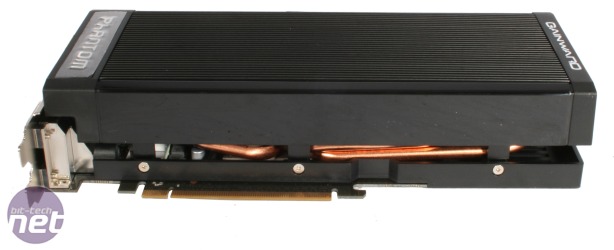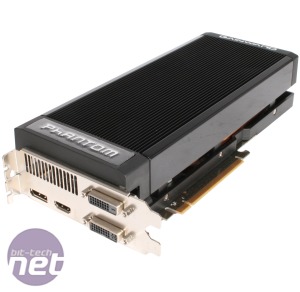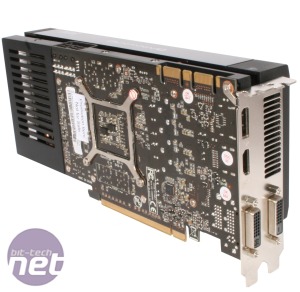Manufacturer: Gainward
UK Price (as reviewed): £329.60 (in VAT)
US Price (as reviewed): Unknown
We were blown away when the GTX 670 2GB first hit the shelves, as, for the price, nothing could touch it for performance; it even managed to outperform vastly more expensive AMD cards like the Radeon HD 6970 3GB in some games. Since then however, AMD has released its much celebrated Catalyst 12.7b driver, which has given most AMD cards the swift kick up the performance backside that they’ve needed to keep pace.
It’s a slightly changed landscape that we view the Gainward GTX 670 2GB Phantom against then, but it’s equipped with a number of tools in its kit bag to help it fend off the red team’s latest charge. Top of this list is a factory overclock - the Phantom runs at a base clock speed of a cool 1,006MHz, which is 91MHz faster than a stock GTX 670 2GB and the exact same base clock speed as a GeForce GTX 680 2GB. Importantly, however, its peak boost frequency hasn't been altered, so it can still only boost to a maximum frequency of 1,084MHz.
Accompanying the core overclock is a small boost to memory speeds, with the Phantom’s GDDR5 modules operating at 6.1GHz rather than the 6GHz of the vanilla card. We have to admit that while we appreciate the boost, a mere 100MHz is less than we expected; we pushed the memory on our test GTX 670 2GB to 6.8GHZ after all.
As you can see from the images, the card also sports a custom cooler - a key addition as, while the stock GTX 670 2GB cooler was quiet under normal operation, it did spin up noticeably when the card was overclocked. The one caveat here however is that the cooler is a triple slot design, meaning you’ll lose access to an extra expansion slot compared with a stock model.
The design of the cooler is a refined version of that which we saw on the Gainward GTX 570 Phantom which means it's based on the same distinctive grilled black box theme - you'd be forgiven for mistaking the card for a 240mm radiator at first glance. Tellingly, the cooler features two less heatpipes than the 5-series version of the card - clearly the GK104 die of the GTX 670 2GB is easier to tame than the GF110 that sat aboard the GTX 570 1.3GB.
Stripping down the card reveals that the three heatpipes of the cooler run through an aluminium, rather than copper, contact plate, and that this only makes contact with the GPU itself, rather than also cooling the RAM chips and VRM circuitry. This is disappointing for a premium card, though Gainward would no doubt point out that the orientation of the fans (which blow down towards the PCB) provides the RAM chips and the passive heatsink sat atop the VRMs with adequate cooling.
This is a fair point, but it also highlights the fact that the Phantom cooler will be dumping the majority of the waste heat it dissipates back into the case it’s in, unlike the stock cooler which is a rear exhausting model. Given the frugality of the GK104 GPU, this isn’t likely to be a huge issue, but it’s worth being aware of.
The PCB of the Phantom is very similar to the stock GTX 670 2GB PCB, with only the addition of some slightly more chunky choke units differentiating it from the Nvidia design. Gainward has also altered the position of the RAM chips - the Nvidia card had them alternating between the rear and front of the PCB, whereas the Phantom houses them all on the front of the PCB, so they all benefit from the airflow provided by the cooler.
Specifications
UK Price (as reviewed): £329.60 (in VAT)
US Price (as reviewed): Unknown
We were blown away when the GTX 670 2GB first hit the shelves, as, for the price, nothing could touch it for performance; it even managed to outperform vastly more expensive AMD cards like the Radeon HD 6970 3GB in some games. Since then however, AMD has released its much celebrated Catalyst 12.7b driver, which has given most AMD cards the swift kick up the performance backside that they’ve needed to keep pace.
It’s a slightly changed landscape that we view the Gainward GTX 670 2GB Phantom against then, but it’s equipped with a number of tools in its kit bag to help it fend off the red team’s latest charge. Top of this list is a factory overclock - the Phantom runs at a base clock speed of a cool 1,006MHz, which is 91MHz faster than a stock GTX 670 2GB and the exact same base clock speed as a GeForce GTX 680 2GB. Importantly, however, its peak boost frequency hasn't been altered, so it can still only boost to a maximum frequency of 1,084MHz.
Accompanying the core overclock is a small boost to memory speeds, with the Phantom’s GDDR5 modules operating at 6.1GHz rather than the 6GHz of the vanilla card. We have to admit that while we appreciate the boost, a mere 100MHz is less than we expected; we pushed the memory on our test GTX 670 2GB to 6.8GHZ after all.
As you can see from the images, the card also sports a custom cooler - a key addition as, while the stock GTX 670 2GB cooler was quiet under normal operation, it did spin up noticeably when the card was overclocked. The one caveat here however is that the cooler is a triple slot design, meaning you’ll lose access to an extra expansion slot compared with a stock model.
The design of the cooler is a refined version of that which we saw on the Gainward GTX 570 Phantom which means it's based on the same distinctive grilled black box theme - you'd be forgiven for mistaking the card for a 240mm radiator at first glance. Tellingly, the cooler features two less heatpipes than the 5-series version of the card - clearly the GK104 die of the GTX 670 2GB is easier to tame than the GF110 that sat aboard the GTX 570 1.3GB.
Stripping down the card reveals that the three heatpipes of the cooler run through an aluminium, rather than copper, contact plate, and that this only makes contact with the GPU itself, rather than also cooling the RAM chips and VRM circuitry. This is disappointing for a premium card, though Gainward would no doubt point out that the orientation of the fans (which blow down towards the PCB) provides the RAM chips and the passive heatsink sat atop the VRMs with adequate cooling.
This is a fair point, but it also highlights the fact that the Phantom cooler will be dumping the majority of the waste heat it dissipates back into the case it’s in, unlike the stock cooler which is a rear exhausting model. Given the frugality of the GK104 GPU, this isn’t likely to be a huge issue, but it’s worth being aware of.
The PCB of the Phantom is very similar to the stock GTX 670 2GB PCB, with only the addition of some slightly more chunky choke units differentiating it from the Nvidia design. Gainward has also altered the position of the RAM chips - the Nvidia card had them alternating between the rear and front of the PCB, whereas the Phantom houses them all on the front of the PCB, so they all benefit from the airflow provided by the cooler.
Specifications
- Graphics processor Nvidia GeForce GTX 670 2GB, 1,006MHz
- Pipeline 1,344 stream processors, 112 Texture Units, 32 ROPs
- Memory 2GB GDDR5, 6.1GHz effective
- Bandwidth 195.5GB/sec, 256-bit interface
- Compatibility DirectX 11.1, OpenGL 4.1
- Outputs/InputsDVI x 2, HDMI, DisplayPort, SLI
- Power connections 2 x 6-pin, top-mounted
- Size 247mm long, triple-slot
- Warranty Two years

MSI MPG Velox 100R Chassis Review
October 14 2021 | 15:04












Want to comment? Please log in.